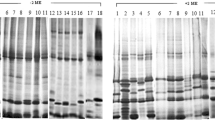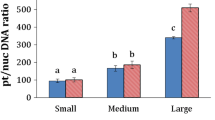Summary
Isozyme expression of malate dehydrogenase (MDH), phosphoglucomutase (PGM), and phosphoglucose isomerase (PGI) were examined from 12 tissues of pecan by starch gel electrophoresis. Tissue type, stage of development, and extraction method had little effect on isozyme expression of MDH or PGM but did influence PGI expression. Additional PGI bands were observed from seed tissue and soaked pollen. A direct relationship was observed between PGI expression from seed tissue and eventual expression from the germinated seedling. Additional PGI bands from soaked pollen were thought to be produced from structural changes and not due to more efficient extraction. The genotype of immature pecan seeds could be determined for Mdh-1, Pgi-2, and Pgm-1 provided cellular endosperm had developed. Watery endosperm did not contain detectable levels of the study enzymes. The advantages of uniform isozyme expression among various tissues and ability to determine the genotype of immature pecan seed are discussed.
Similar content being viewed by others
References
Adams W.T., 1983. Application of isozymes in tree breeding. p 381–400. In: S.D. Tanksley & T.J. Orton (Eds.) Isozymes in plant genetics and breeding. Part A, Elsevier, Amsterdam.
Arulsekar S., D.E. Parfitt & G.H. McGranahan, 1985. Isozyme gene markers in Juglans species. Inheritance of GPI and AAT in J. regia and J. hindsii. J Hered 76: 103–106.
Arulsekar S. & D.E. Parfitt, 1986. Isozyme analysis procedures for stone fruits, almonds, grape, walnut, pistachio, and fig. HortScience 21: 928–933.
Bergh B.O., 1975. Avocados, p 541–557. In: J. Janick & J.N. Moore (Eds.). Advances in fruit breeding. Purdue Univ Press, West Lafayette, Indiana.
Cheliak, W.H. & J.A. Pitel, 1984. Techniques for starch gel electrophoresis of enzymes from forest tree species. Petawawa Natl For Inst Rpt PI-X-42.
Conkle, M.T., P.D. Hodgekiss, L.B. Nunnaly & S.C. Hunter, 1982. Starch gel electrophoresis of conifer seeds: a laboratory manual. Pacific Southwest For and Range Exp Sta, Berkely, Calif Tech Rpt PSW-64.
Degani C., A. Goldring, S. Gazit & U. Lavi, 1986. Genetic selection during abscission of avocado fruitlets. HortScience 21: 1187–1188.
Feret P.P., 1971. Isozyme variation in Picea glauca (Moench) Voss. Silvae Genet 20: 46–50.
Hansche P.E. & W. Beres, 1980. Genetic remodeling of fruit and nut trees to facilitate cultivar improvement. HortScience 15: 710–715.
Peirce L.C. & J.L. Brewbaker, 1973. Applications of isozyme analysis in horticultural science. HortScience 8: 17–22.
McKay J.W., 1947. Embryology of pecan. J Agr Res 74: 263–283.
Marquard R.D., 1987. Isozyme inheritance, polymorphism, and stability of malate dehydrogenase and phosphoglucose isomerase in pecan. J Amer Soc Hort Sci 112: 717–721.
Marquard R.D., 1988. Outcrossing rates in ‘Western’ pecan and the potential for increased yields. J Amer Soc Hort Sci 113: 84–88.
Scandalios J.G., 1974. Isozymes in development and differentiation. Ann Rev Pl Physiol 25: 225–258.
Sparks D. & G.D. Madden, 1985. Pistillate flower and fruit abortion in pecan as a function of cultivar, time, and pollination. J Amer Soc Hort Sci 110: 219–223.
Temme D.H., 1986. Seed size variability: a consequence of variable genetic quality among offspring. Evolution 40: 414–417.
Torres A.M., 1983. Fruit trees, p 401–422. In: S.D. Tanksley & T.J. Orton (Eds.). Isozymes in plant genetics and breeding. Part B. Elsevier, Amsterdam.
Torres A.M., 1984. Isozymes from avocado cotyledons. J Hered 75: 300–302.
Vallejos C.E., 1983. Enzyme activity staining. In: S.D. Tanksley & T.J. Orton (Eds.). Isozymes in plant genetics and breeding. Part A. Elsevier, Amsterdam.
Weeden N.F. & L.D. Gottlieb, 1979. Distinguishing allozymes and isozymes of phosphoglucose isomerase by gel electrophoresis comparisons of pollen and somatic tissue. Biochem Genet 17: 287–296.
Weeden N.F. & L.D. Gottlieb, 1980. Isolation of cytoplasmic enzymes from pollen. Plant Physiol 66: 400–403.
Weeden N.F. & R.C. Lamb, 1985. Identification of apple cultivars by isozyme phenotype. J Amer Soc Hort Sci 110: 509–515.
Weller D.L. & J.F. Constante, 1986. Peroxidase zymograms of 16 apple rootstocks. Can J Plant Sci 66: 647–652.
Woodroof, J.G., N.C. Woodroof & J.E. Bailey, 1928. Unfruitfulness of the pecan. Ga Expt Sta Bul 148.
Woodroof J.G. & N.C. Woodroof, 1927. The development of pecan nut from flower to maturity. J Agr Res 34: 1049–1063.
Author information
Authors and Affiliations
Rights and permissions
About this article
Cite this article
Marquard, R.D., Skorpenske, R.G. Expression of heritable biochemical markers from various pecan tissues. Euphytica 42, 65–70 (1989). https://doi.org/10.1007/BF00042616
Received:
Accepted:
Issue Date:
DOI: https://doi.org/10.1007/BF00042616




